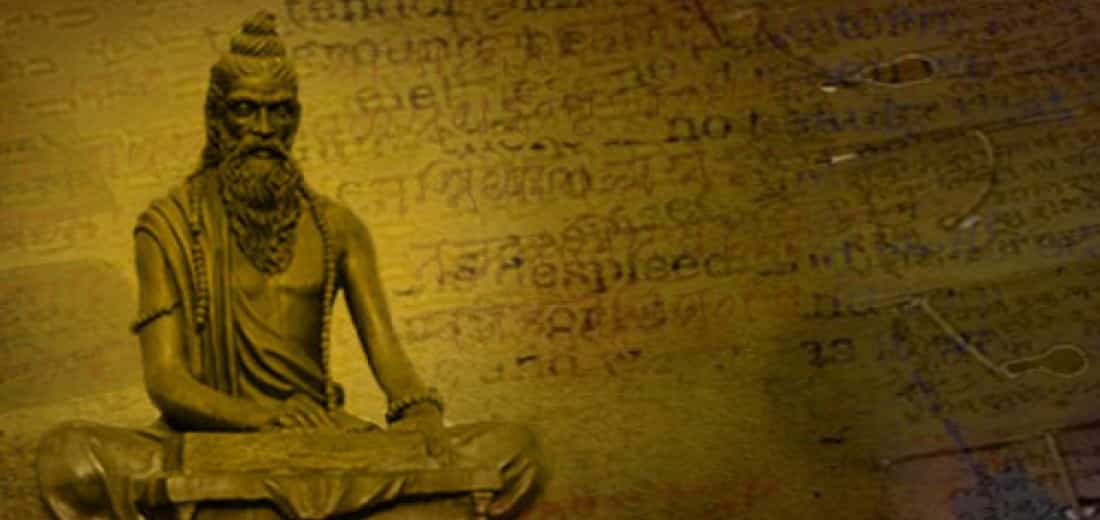The four parts or chapters (Pada) of the Yogasutra are:
There are 51 sutras in Samadhi Chapter, 55 Sutras in Sadhna Chapter, 55 Sutras in Vibhuti Chapter and 34 Sutras in Kaivalya Chapter. Altogether 195 sutras are available in the complete Yoga Sutras. Subject-wise, in these 195 sutras, various topics of yoga have been briefly explained.
YOGA SUTRAS - THE PRACTICAL TEXTBOOK TO YOUR SPIRITUAL JOURNEY
- SAMADHI
- SADHANA
- VIBHUTI
- KAIVALYA

SAMADHI
The first chapter deals with the nature of elemental yoga and some of its techniques. It tries to answer the question "What is yoga?" The state of samadhi is the essence of yoga. Therefore, Samadhi is discussed extensively in this section. This chapter also throws light on the nature of the human mind (chitta) and all its unstable states (vichitti).
Under Samadhi Pada, the main topics related to Samadhi have been taken. In this chapter, the definition of yoga has been given for the first time, which is defined as the state of being restrained in all respects of the mind. Here it has also been made clear that this yoga is samadhi. The means of attaining the state of Samadhi have also been discussed in detail. According to the scholars, the practices mentioned in this chapter are not for the general practitioner but for the professionals of a high order. The practices have been discussed here keeping in mind those whose mind is already stable.
Ishwar Pranidhana or Ishwar Bhakti (Ishwar Pranidhana will be discussed in detail in the fourth unit) and the nature of God has also been discussed in this chapter. It is because of the description of God that sometimes a distinction is made between Samkhya and Yoga. While Samkhya does not describe God, Yoga (Patanjala Yoga) is sometimes known as Sesvara-Samkhya because of its description of God.
In this way, along with discussing various topics in detail, an attempt has been made to keep the philosophical nature of Yoga in a very beautiful way under Samadhi Pada. From the mind to samadhi, the distinctions and measures for controlling the mind etc. have also been explained in this chapter. After studying you will automatically get an assessment of the philosophical background of Yoga.

SADHANA
The second section discusses the nature of tribulation and attempts to find a solution to human suffering. It raises the question that "why should we practice yoga?" It provides a good analysis of human life and its conditions.
In Sadhana Pad, many measures have been told to achieve yoga. It has been made clear at the beginning of this chapter that Kriya Yoga is the best for a beginner or a common man. Under Kriya Yoga, austerity, self-study and God worship have been included. This chapter begins with a detailed discussion of this. In this chapter, you will also find a later discussion of Ashtanga Yoga. It includes Yama, Niyama, Asana, Pranayama, Pratyahara, Dharana, Dhyana and Samadhi. The first five components of these eight components are called Bahiranga Yoga or Yoga forms of external nature. These five components can be referred to as the components of the initial preparation. The latter three components (Dharana, Dhyana, and Samadhi) are said to be components of inner yoga because they work to cultivate the inner self. Their practice leads us to the inner yoga in which the state of samadhi is embodied.
Ashtanga yoga is the most popular spiritual practice, which can be seen in almost all studies on yoga. This chapter prepares us mentally, physically, emotionally and morally for yoga.
Along with the discussion of the different parts of Ashtanga Yoga, the siddhis obtained from them are also described here. Due to this, the description of Ashtanga Yoga received here cannot be compared with any other place. Various philosophical topics are also described in this chapter. In which 'Drishta' and 'Vishya' are prominent. Only having knowledge of wisdom in both of these leads to the attainment of yoga. Due to the combined state of these two, the state of ignorance persists.
This chapter itself as a whole presents a detailed view of the various philosophical aspects of Yoga. The principle of karma also comes under this chapter.

VIBHUTI
The third section is the Vibhuti; the first part of which throws light on the last three components (samadhi) of inner yoga and Ashtanga yoga in detail. These high technologies reveal the secrets of yogic life. Divine powers (Vibhutis and Siddhis) are experienced.
Beginning with Dharana, Dhyana and Samadhi, the inclusion of very mysterious and interesting subjects is seen in this chapter. The mention of philosophical subjects here is rarely seen as compared to the earlier chapters. Nevertheless, the importance of this chapter is not less from a philosophical point of view. In philosophical subjects, the nature of religion, righteousness, etc. and the results of the mind are discussed. Along with this, Dharana, Dhyana and Samadhi are collectively described here as "Sanyam" or "Control". It is a major part of the definitional terminology of the Yoga Sutras. Generally, it refers to control, but here its use is described as a combination of Dharana, Dhyana and Samadhi. Along with all these subjects, the main theme of this chapter is the description of the personalities born of restraint. That is why this chapter has been named Vibhuti Pada.

KAIVALYA
Kaivalya pada is the last chapter of this book. It deeply investigates the philosophical problems related to the practice of yoga. This chapter covers the essential nature of the mind, the cosmic concept, the voluntary nature of man and how desires are the cause of adaptation and bondage. It further explains how the state of liberation (kaivalya) can be experienced and what principle is derived from such pure consciousness.
This chapter is going to describe the position of Kaivalya, the ultimate goal of yoga. The philosophical nature of yoga is also discussed in this chapter. This chapter begins with the description of five types of siddhis, in which it is told that siddhis are attained by birth, by medicine, by the mantra, by penance and through samadhi. It describes that samadhi is considered pure.
In the end, by telling the nature of Kaivalya, with the end of this chapter, the Yogasutra also gets completed. This chapter is shorter than the earlier chapters. But, without this, the Yoga Sutra is not complete. For this reason, the importance of this chapter increases even more.
PATANJALI - ONE WHO PRESENTED THE FIRST TEXT ON YOGA
Adiyogi was the one who started yoga in the world, he was the first to spread the knowledge of yoga to his seven disciples in order to spread it all over the world. The seven disciples to whom Adiyogi had given the knowledge of yoga are known as Saptarishi. Those seven sages, while promoting yoga, worked to bring it to the common people with different specializations. Patanjali was one of those seven sages, because the knowledge of yoga is very vast, and is not easily understood by the common man. Therefore, collecting the main parts of yoga, he made 195 sutras and divided them into four parts. The way in medical science there are different doctors and treatments available for every body part. Similarly, there are some special rules, methods and practitioners for yoga for different parts.
Patanjali was the only person who gave a systematic form to yoga and compiled it in a sutra form through his book. It helped a lot in knowing the position of Yoga in other philosophical schools. The antiquity of the Yoga Sutras has been clearly stated from a historical point of view. If the Yoga Sutras date back to the 2nd century BCE, without getting into any controversy, it can be seen to have a clear impact on other philosophies that developed after it.
Apart from the Yoga Sutras, he was also known to create and compiled Mahabhasya. It is written in the Sanskrit language which presents the information on Charaka Samhita.
GATHER THE INFORMATION ON PATANJALI YOGA SUTRAS
Here are various yoga schools offering courses and programs on yoga. The curriculum of the course includes theoretical classes as well apart from practical sessions. Yoga Philosophy is taught in theory class which covered the detailed information about Patanjali Yoga Sutra. While going through it, you will get to know about the history, origin, and rules of yoga.
If you are interested in learning and gathering the detailing of the Patanjali Yoga Sutra, then you are all invited to join a yoga class at Real Happiness India, a yoga school in Rishikesh.
To know more, you can visit www.realhappiness.org
You will surely be elated after gaining the complete information and knowledge of yoga with Patanjali Yoga Sutras


